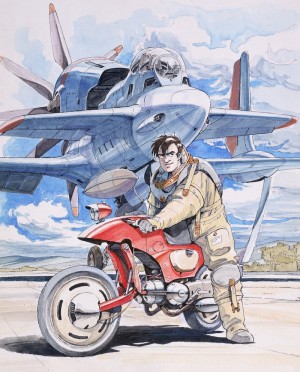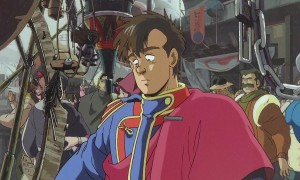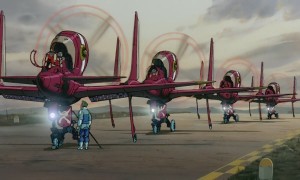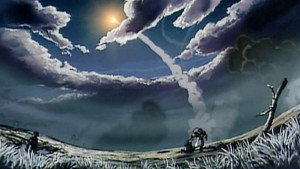The Wings of Honneamise
April 7, 2015 · 1 comment
By Andrew Osmond
 The Wings of Honneamise, Studio Gainax’s debut film, opened in Japanese cinemas in March 1987, just over a year before Akira. While the films are very different, they share common ground; they’re both anti-establishment SF movies which could be made in lavish style, thanks to Japan’s national prosperity in the 1980s. Those were the country’s bubble years, and Honneamise and Akira splurged on bubble money to break with Japanese animation practices. They didn’t deliver franchise tie-ins or family entertainment. Instead they served up intense visions of society and humanity, sold not by merchandise but incredible screen spectacle.
The Wings of Honneamise, Studio Gainax’s debut film, opened in Japanese cinemas in March 1987, just over a year before Akira. While the films are very different, they share common ground; they’re both anti-establishment SF movies which could be made in lavish style, thanks to Japan’s national prosperity in the 1980s. Those were the country’s bubble years, and Honneamise and Akira splurged on bubble money to break with Japanese animation practices. They didn’t deliver franchise tie-ins or family entertainment. Instead they served up intense visions of society and humanity, sold not by merchandise but incredible screen spectacle.
Honneamise tells the story of a young man, Shiro (short for ‘Shirotsugh,’ though his nickname is handily Japanese). He lives on a world whose culture and technology differ from ours in intricate ways, in the smallest details of costumes, tableware, street lights. Shiro’s world hasn’t conquered space; its “Royal Space Force” is regarded as a pitiful place for geeks and freaks. Yet Shiro finds himself volunteering to be the world’s first astronaut, for the most adolescent of reasons – an urge to impress a beautiful woman.
The film can be read as a grandiose statement on human nature, and on humanity’s drive to rise, to fly. It can be also be seen as a self-portrait of its creators, of fanboys who were suddenly given the resources to create their own masterwork. The team who’d make Honneamise and found Gainax came together in the early 1980s. They made stunningly elaborate fan animations for the Daicon convention in Osaka, where a bunny-suited girl fights mecha, Aliens and Darth Vader.
Another important training ground was Macross in 1982 (reworked into the first arc of Robotech). Hiroyuki Yamaga, Honneamise’s future director, designed the storyboards for Macross’s title sequence, in which a jet takes off from a carrier. The image is seemingly referenced in the pre-titles prologue of Honneamise. Hideaki Anno – yes, that Anno, future creator of Evangelion – was a Macross animator, specialising in mecha and explosions. He especially loved exploding objects, tracing the paths and patterns of debris through the air.
Macross would become a decades-long franchise, following the precedents of Gundam and Space Battleship Yamato. In Anime: A History, Jonathan Clements suggests that Bandai, the film’s financial backer, hoped to bootstrap a similar franchise with Honneamise. Indeed, Bandai owned the Sunrise studio, home of Gundam. No doubt Bandai had high hopes for Honneamise merchandise – the Gainax team had a track record in creating homemade garage kits.
 For such reasons, Honneamise ballooned from a low-budget video anime into a costly feature film. Clements notes that by the time it entered production, it had picked up a raft of sponsors and investors, including an airline which insisted that the film’s title include “Wings.” It was given a budget of around $8 million (including $5 million from Bandai), a tremendous sum for Japanese animation at the time. The Oscar-winning composer Ryuichi Sakamoto was hired, writing four main themes that were complemented by music from two other composers.
For such reasons, Honneamise ballooned from a low-budget video anime into a costly feature film. Clements notes that by the time it entered production, it had picked up a raft of sponsors and investors, including an airline which insisted that the film’s title include “Wings.” It was given a budget of around $8 million (including $5 million from Bandai), a tremendous sum for Japanese animation at the time. The Oscar-winning composer Ryuichi Sakamoto was hired, writing four main themes that were complemented by music from two other composers.
The film-makers went to town. Yamaga was the director, but the film was a group effort through and through, according to Gainax’s first president Toshio Okada. “On a Gainax project, everyone has to be a director,” Okada told Carl Gustav Horn for Animerica magazine. “Therefore everyone’s feelings and everyone’s knowledge are going into it, creating all that detail.” Hence the multiple musicians. “(Honneamise) has a very differentiated structure, and we needed a score to match that.”
Anno drew huge amounts of the film’s spectacle, including the wonderful early test flight, whose hand-drawing shames the twenty-first century CG planes of The Sky Crawlers or The Princess and the Pilot. He also drew the insanely epic battle which rages before and during a rocket’s take-off (and yes, Anno drew the take-off, too). In an interview in the new Anime Limited edition, Yamaga remembers that even before he’d determined the story, he already wanted a climax to take advantage of Anno’s talents. “Creators come first and this is a story I made thinking what story those creators would shine at the most.”
Yamaga also recalls driving the Gainax artists to create an imaginary civilisation systematically, from the ground up. For example, if they were designing a glass of water, they shouldn’t just go for an “interesting” design, but think about the basic purpose of the glass – to hold water – and reconceive it from there. “I urged all the staff to go through that kind of thought experiment… I adjusted their brains to ‘Honneamisish,’ Yamaga said.
The director had a goal in creating a world with myriad similarities and differences to ours; to redefine everyday life. Honneamise was made before the rise in everyday (nichijo) anime, when animating ordinary life became ordinary. “Back then, I just wasn’t confident in depicting details enough to depict everyday life,” Yamaga said. He wanted a world of small differences to get viewers to pay attention to minor details. “If we led the audience to a kind of transformed everyday life, after they watch the movie, they would think the reality we lived in was pretty fun.”
Yamaga notes that early in Honneamise’s development – reflected in a four-minute pilot film with different designs and animation – the anime was close to a Ghibli film. Indeed, Ghibli came out of Nausicaa of the Valley of Wind, a film with one of the most detailed imaginary worlds in anime. Yamaga acknowledges that a Ghibli-style Honneamise might have been more “balanced and stable,” not just for the film staff, “but also for sponsors, motion picture staff and the media… It would have been easier to grasp and express. But if we had done that, I don’t think any of the Gainax works after that would have been successful at all.”
 The point of Honneamise, Yamaga says, is that it defied the commercial consensus around animated films – for example, that they should appeal to both children and adults, like early Ghibli. Yamaga was determined to take his own tack. “When I look at my work again, there are so many awkward and strange points… While making Honneamise, it was like we were all swinging swords blindfolded.”
The point of Honneamise, Yamaga says, is that it defied the commercial consensus around animated films – for example, that they should appeal to both children and adults, like early Ghibli. Yamaga was determined to take his own tack. “When I look at my work again, there are so many awkward and strange points… While making Honneamise, it was like we were all swinging swords blindfolded.”
The film became a very adult drama about an immature protagonist who often drifts, is passively impressionable, and turns out to be shockingly flawed. There are obvious comparisons to Gainax’s later Evangelion, with its neurotic hero Shinji. Ghibli’s Tales from Earthsea also had a lost protagonist in a lost world. But it was a risky kind of story. Earthsea was hated by many viewers, while Honneamise may have baffled them, judging by the film’s modest cinema box-office in Japan.
Notoriously, the promoters (the advertising company Toho-Towa) tried to sell the film as a fantasy along the lines of Nausicaa. There’s a detailed account in Clements’ Anime: A History, including one farcical episode known as the Insect Incident. Honneamise has a scene in which a child is shown keeping a spider-beetle creature as a pet. Toho-Towa approached Yoshiyuki Sadamoto, who was the character designer and animation director, and commissioned him to draw an image of the insect attacking a city! (Such imagery appeared in Nausicaa, but had nothing to do with Honneamise.)
The Insect Incident infuriated Okada, who remarked that the time wasted on the bogus poster could have been spent improving the film itself. In Animerica, Okada bluntly called Honneamise an art picture. “At the time, I thought that was very good – an anime art film. But now when I look back, I realise, this was a major motion picture. Bandai spent a lot of money on it… Maybe if I’d given it a little stronger structure, and a little simpler story, it could have met the mainstream.”
 Okada added that Honneamise didn’t connect with anime fans in Japan either. “In those days, Project A-Ko was what most fans thought of as good, and such money-making anime was the type promoted in the industry, which put Honneamise in a difficult place.” Ironically, Project A-ko’s writer-director Yuji Moriyama served on Honneamise as an animation director.
Okada added that Honneamise didn’t connect with anime fans in Japan either. “In those days, Project A-Ko was what most fans thought of as good, and such money-making anime was the type promoted in the industry, which put Honneamise in a difficult place.” Ironically, Project A-ko’s writer-director Yuji Moriyama served on Honneamise as an animation director.
In America, Honneamise could have been buried in a travestied dub (as Nausicaa was with Warriors of the Wind.) The first US version was called Star Quest; it changed character names (Shiro became “Randy Wilson”) and mucked with characterisations. Mercifully, Star Quest quickly vanished and a more faithful dub of Honneamise was created by LA Hero. During production the company was bought out and rebranded as the American arm of Manga Entertainment.
The dub’s lead actors (Robert Matthews and Melody Lee) appeared in only a few anime, but there are some very familiar voices in bit parts, including Richard Epcar, Steven Blum and Wendee Lee. Matti, one of the film’s supporting characters, was voiced by Bryan Cranston, long before his world fame in Breaking Bad. The dub script, however, still takes liberties with the original, though nothing as atrocious as Star Quest For example, Shiro’s final speech in the film has a notably different tone in the dub and sub versions.
In contrast to its reportedly lukewarm reception by Japanese anime fans, the film was enthusiastically embraced by their American counterparts. Many of them had been wowed by Akira, Honneamise’s successor, and now found that Gainax’s film treated SF in a far lower-key, cerebral way. But even among those fans, Honneamise was controversial for one scene. The scene in question involves a sexual assault, which many viewers found offensive and unnecessary (and arguably slightly more offensive in the dubbed version).
Again, Okada blamed the screenplay for leaving the scene’s meaning and motivations unclear, and losing the audience. The scene was cut out of the first UK home release of Honneamise in the 1990s; Manga Entertainment made the edit voluntarily to get the film a ‘PG’ certificate. Interviewed by Manga Mania magazine, the BBFC examiner Imtiaz Karim called the scene “a wholly gratuitous sexual assault in the middle of a film which was otherwise a wonderful experience for younger viewers.” Anime Limited plans to include an option for viewers to skip the scene.
 Despite the controversy, Honneamise was a huge boost to anime’s international reputation. In Japan, there was no question of the film turning a profit in cinemas, but it became an enduring fixture of the video and later DVD market, with no risk of its sumptuous visuals dating. It finally turned an official profit in 1994, the same year it came to America.
Despite the controversy, Honneamise was a huge boost to anime’s international reputation. In Japan, there was no question of the film turning a profit in cinemas, but it became an enduring fixture of the video and later DVD market, with no risk of its sumptuous visuals dating. It finally turned an official profit in 1994, the same year it came to America.
Studio Gainax was nearly bankrupted, but survived – because, Clements says, “Its managing director did not possess the business acumen to pronounce the company dead.” A few years later, after Japan’s national bubble had burst, Gainax made the kind of cash-cow that Bandai had dreamed of with Honneamise – Evangelion.
Many fans know Gainax considered a sequel to Honneamise, although there’s some confusion in this area. According to Animerica, Yamaga and Okada talked about a sequel set a century later, in which a spaceship from the world of Honneamise journeys to Earth in the present day or the near future. However, this idea is distinct from another planned film, Blue Uru, which may yet be made.
Blue Uru was conceived as a “successor” but not sequel to Honneamise. It’s the story of a plane pilot trying to save a kidnapped singer; Okada compares it to Walter Hill’s retro-styled biker fantasy Streets of Fire (1984). The anime was planned to reunite Honneamise’s core talents, Yamaga, Anno and Sadamoto. The first bid to make Blue Uru was in the early ‘90s, with several attempts to revive it in the next two decades. A CD-ROM of the film’s designs, including planes by Masamune Shirow and Yamaga’s original script, was released in 1998.
According to an announcement in December 2014, Blue Uru is still seeking collaborators, with Yamaga (writer/director) and Sadamoto (designs) both attached. Anno, understandably, is otherwise engaged. The film’s projected budget is $40 million while the hoped-for release date is 2018, thirty-one years after Honneamise. Do its makers still have the right stuff? After decades in the business, can they still remember when they were hungry misfits, their own metaphorical space force, longing to leave Earth and enter their dreams?
Andrew Osmond is the author of 100 Animated Feature Films. The Wings of Honneamise is available now in a DVD from Anime Ltd, and as a Blu-ray/DVD Collectors Edition combi-pack.
Anime Limited Newswire #15 – 14th April 2015 – All the Anime
April 16, 2015 9:19 am
[…] Behind The Scenes of Wings of Honneamise […]
dwayne jones
April 3, 2023 5:00 pm
Very late to the game here, but I feel the need to opine here. I worked on the scripting and subtitling for the Sentai Filmworks bluray rerelease of Royal Spafe Force: Wings of Honneamise. As I was working through the scene, I realized something that had escaped me all these years since I very first saw this title. Shirotsugh was sleepwalking through the whole event. He had fallen asleep, disillusioned after seeing Riqunni's stash of deem coins in her shoe. The implication, of course, was that she had been resorting to prostituting herself. As he watched her in his sleep, snoring with his eyes open, he acted on his subconscious anger: she had constantly rebuffed his advances (out of her admiration for him) and in the end turned out to offer herself to any man who paid her. It was in the middle of the assault that he woke up and in that confused pause of his, she knocked him out. It was after watching that movie in slow motion that I noticed those subtle and unspoken clues. I admit I alarmed the entire production floor when I shouted "HE'S SLEEPWALKING!" when I realized it. I'm not sure if this has been brought up anywhere else, but thought I would at least come to the defense of That One Scene in a phenomenal property. (I still can't show my mother that scene, though. even despite the explanation...) Thanks for your review, and thanks for listening.